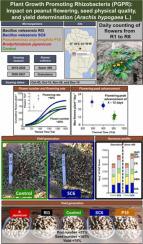当前位置:
X-MOL 学术
›
Ind. Crops Prod.
›
论文详情
Our official English website, www.x-mol.net, welcomes your feedback! (Note: you will need to create a separate account there.)
Plant Growth Promoting Rhizobacteria (PGPR): Impact on peanut flowering, seed physical quality, and yield determination (Arachis hypogaea L.)
Industrial Crops and Products ( IF 5.6 ) Pub Date : 2024-06-24 , DOI: 10.1016/j.indcrop.2024.119024 E.D. Bigatton , M.A. Castillejo , Ayoub , J.J. Baldessari , M. Bruno , M.V. Archilla , L.E. Dubini , E. Lucini , R.J. Haro
Industrial Crops and Products ( IF 5.6 ) Pub Date : 2024-06-24 , DOI: 10.1016/j.indcrop.2024.119024 E.D. Bigatton , M.A. Castillejo , Ayoub , J.J. Baldessari , M. Bruno , M.V. Archilla , L.E. Dubini , E. Lucini , R.J. Haro

|
Peanut seed yield is influenced by physiological and ecophysiological crop traits, with changes in reproductive parameters such as flowering time, flower number, and fertility index significantly affecting productivity. Management practices like Plant Growth-Promoting Rhizobacteria (PGPR) could enhance crop yield. PGPR can improve flowering and yield by modulating the balance of phytohormones and enhancing reproductive processes. This study assessed PGPR effects on peanut flowering dynamics, seed yield determination, and correlation with hormone levels. Two plant-level field experiments were conducted during 2019–2020 and 2020–2021, sowing two cultivars (ASEM 400 INTA and Granoleico) on four sowing dates (Oct-05, Oct-15, Nov-29, Dec-10). Three PGPR strains ( RI3 and SC6, P10), , and control were arranged in a split-split-split-plot design, with sowing dates as main plots, cultivars as sub-plots, and PGPRs as sub-sub-plots. PGPR improved peanut flower number (FN) and flowering rate (FR) by 20 % and 50 % compared to and the control. SC6 showed the best performance (SC6 > P10 > RI3), advancing the flowering peak by 4–12 days. PGPR also increased the fertility index (FI) to 0.31 vs. 0.24 of B. japonicum and control and pod number (PN) by 53 % compared to the control. Flowering peak advancement led to larger seeds (SF≥8 mm) (∼+8 % vs. control) due to better environmental conditions (i.e., higher temperatures). Seed number (SN) increased by 94 %–113 % under PGPR treatments. Seed yield (SY) was increased (∼75 % on average) due to higher total biomass (TB) production and improved carbon allocation to seeds (harvest index; 0.33–0.36). Hormone analysis at the R5 stage under late sowing's restrictive conditions showed hormone level increases of 15 %–90 %. This study demonstrates that PGPR significantly improves peanut flowering dynamics, seed quality, and yield by affecting hormone levels and reproductive parameters, highlighting its potential as a sustainable management practice.
中文翻译:

植物促生根际细菌 (PGPR):对花生开花、种子物理品质和产量测定的影响(Arachishypogaea L.)
花生种子产量受作物生理和生态生理性状影响,开花时间、花数、肥力指数等生殖参数的变化显着影响产量。促进植物生长的根际细菌 (PGPR) 等管理实践可以提高作物产量。 PGPR 可以通过调节植物激素的平衡和增强生殖过程来提高开花和产量。本研究评估了 PGPR 对花生开花动态、种子产量测定以及与激素水平的相关性的影响。在2019-2020年和2020-2021年期间进行了两次植物级田间试验,在四个播种日期(10月5日、10月15日、11月29日、12月10日)播种两个品种(ASEM 400 INTA和Granoleico)。 3个PGPR品系(RI3和SC6、P10)和对照采用裂-裂-裂小区设计,以播种期为主小区,品种为次小区,PGPR为次小区。与对照相比,PGPR使花生花数(FN)和开花率(FR)分别提高20%和50%。 SC6表现出最好的性能(SC6 > P10 > RI3),将开花高峰提前4-12天。 PGPR 还将日本芽孢杆菌和对照的育性指数 (FI) 提高到 0.31,而对照的 0.24,并且与对照相比,荚数 (PN) 增加了 53%。由于更好的环境条件(即更高的温度),开花高峰提前导致了更大的种子(SF≥8mm)(与对照相比~+8%)。 PGPR 处理下的种子数 (SN) 增加了 94%–113%。由于总生物量(TB)产量的提高和种子碳分配的改善(收获指数;0.33-0.36),种子产量(SY)增加(平均约75%)。在晚播限制条件下,R5 阶段的激素分析表明,激素水平增加了 15%–90%。 这项研究表明,PGPR 通过影响激素水平和繁殖参数,显着改善花生开花动态、种子质量和产量,凸显了其作为可持续管理实践的潜力。
更新日期:2024-06-24
中文翻译:

植物促生根际细菌 (PGPR):对花生开花、种子物理品质和产量测定的影响(Arachishypogaea L.)
花生种子产量受作物生理和生态生理性状影响,开花时间、花数、肥力指数等生殖参数的变化显着影响产量。促进植物生长的根际细菌 (PGPR) 等管理实践可以提高作物产量。 PGPR 可以通过调节植物激素的平衡和增强生殖过程来提高开花和产量。本研究评估了 PGPR 对花生开花动态、种子产量测定以及与激素水平的相关性的影响。在2019-2020年和2020-2021年期间进行了两次植物级田间试验,在四个播种日期(10月5日、10月15日、11月29日、12月10日)播种两个品种(ASEM 400 INTA和Granoleico)。 3个PGPR品系(RI3和SC6、P10)和对照采用裂-裂-裂小区设计,以播种期为主小区,品种为次小区,PGPR为次小区。与对照相比,PGPR使花生花数(FN)和开花率(FR)分别提高20%和50%。 SC6表现出最好的性能(SC6 > P10 > RI3),将开花高峰提前4-12天。 PGPR 还将日本芽孢杆菌和对照的育性指数 (FI) 提高到 0.31,而对照的 0.24,并且与对照相比,荚数 (PN) 增加了 53%。由于更好的环境条件(即更高的温度),开花高峰提前导致了更大的种子(SF≥8mm)(与对照相比~+8%)。 PGPR 处理下的种子数 (SN) 增加了 94%–113%。由于总生物量(TB)产量的提高和种子碳分配的改善(收获指数;0.33-0.36),种子产量(SY)增加(平均约75%)。在晚播限制条件下,R5 阶段的激素分析表明,激素水平增加了 15%–90%。 这项研究表明,PGPR 通过影响激素水平和繁殖参数,显着改善花生开花动态、种子质量和产量,凸显了其作为可持续管理实践的潜力。











































 京公网安备 11010802027423号
京公网安备 11010802027423号